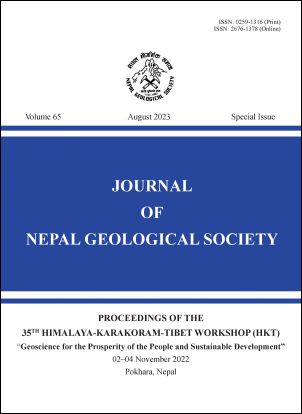Stability assessment for proposed Hemja-Patichaur road tunnel using empirical and analytical methods, western Nepal
DOI:
https://doi.org/10.3126/jngs.v65i01.57746Keywords:
RMR, Q-system, rock mass quality, tunnel and stability assessmentAbstract
Stability assessment is an important aspect for the safety and proper design of underground structures. This paper aims to analyze the stability issues for the proposed 13 km long road tunnel alignment along the Pokhara-Baglung Highway which stretches from the southeast Hemja (Kaski District) to the northwest Patichaur (Parbat District), Gandaki Province, Nepal. For this purpose, initially, an engineering geological mapping in the field was conducted followed by comprehensive analysis of stability. The study has shown that rock mass class within the proposed tunnel stretch ranges from good to extremely poor as per Q and RMR systems of rock mass classification. In this study, stability assessment was carried out by empirical methods and analytical methods. The sections along tunnel alignment were selected for stability study according to the overburden, rock class and presence of weakness zones. The study concluded that empirical methods has shown squeezing conditions at four sections and non-squeezing conditions at four sections as per Q-values. Similarly, analytical methods have shown the rock bursting condition as stable at the roof at most of the sections except minor spalling at some sections. However, the tunnel wall may suffer severe rock bursting with increased in-situ stress conditions of the rock mass. Further, the instantaneous and final deformation of the tunnel was obtained by Panthi and Shrestha’s approach as less than one percent which is negligible.
Downloads
Downloads
Published
How to Cite
Issue
Section
License
© Nepal Geological Society




